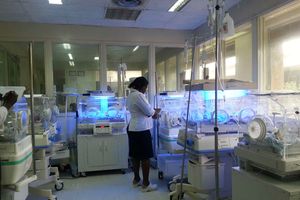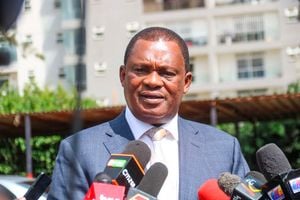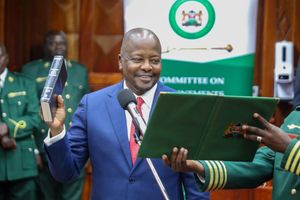Hope at last: Baby born weighing just 400 grammes turns 12

Hope Obonyo. She was born weighing 400 grammes.
What you need to know:
- Hope let out a faint cry after delivery. She was so tiny that the nurse held her in just one hand and her two little feet were dangling down her palm.
- From my bed, I couldn’t even tell the gender as the reproductive organs were not fully developed, but the nurse confirmed that it was a girl.
On August 11, 2011, Baby Hope Obonyo was born prematurely weighing 400 grammes at Kenyatta National Hospital (KNH).
At the time, media reports termed the delivery a miracle—the first surviving case of an extremely preterm baby at Kenya’s largest hospital.

Hope inside an incubator at Kenyatta National Hospital in 2011.
Babies born too early are fragile and underdeveloped and there is a high risk of death or serious disability, according to the World Health Organization.
Fast forward to 12 years.
When the Healthy Nation team visited the family at their home in Nyang’oma village in Bondo, Siaya County, Hope’s mother, Winfrider Areri, reflected on the journey punctuated by health challenges.
“I sat on the edge of the seat at the doctor’s office, my thoughts racing faster than my heartbeat. I was lost in what he had just said.
When I entered the room, I was basking in the new-found journey of motherhood. I was newly employed as a teacher at a secondary school in Wajir where I worked with my husband, Lawrence Obonyo. We were elated with the hope of having our first child after almost two years of dating. One morning, then aged 28, I woke up to discover that I was bleeding. I was eight weeks into my pregnancy, barely quarterly to the ideal finish line of 40 weeks.

Hope alongside her parents, Lawrence (left) and Winfrider (second left) during her first birthday celebration at Kenyatta National Hospital in 2012
The doctor said I had lost the pregnancy and recommended that I consult a counsellor and proceed with the necessary procedure to clean the uterus, a standard protocol after a miscarriage.
With a quiver in my voice, I said: “I want to have an ultrasound. I want to see my baby and at least have a semblance of closure.”
I was led to an adjacent room and as I lay on the bed, I was calling on God.
In a pleasant twist, the scan showed something different. There, on the screen, I saw not one, but two heartbeats. I was carrying twins and I could hear their heartbeats. The bleeding, I was told, was a result of the multiple fibroids that were growing on the uterine wall.
In reflection, if I hadn’t insisted on that scan, the opportunity to become a biological mother would have forever eluded me. Although the doctor profusely regretted saying that I had lost the pregnancy, the memory still sends shivers down my spine.

Hope during a past school tour when she was in Grade Two.
Following that hospital visit, I was determined to do whatever it took to witness the safe delivery of the babies. I rested when my body demanded of it and when it was evident that I needed specialised attention, I boarded a flight to Nairobi, my very first flight, concerned that the long journey via road could jeopardise the pregnancy.
In Nairobi, I consulted a specialist who revealed that I was battling multiple fibroids and they were growing at a fast rate. He labelled my pregnancy high-risk and prescribed total bed rest for at least two weeks.
Weeks turned into months and I ended up on bed rest for three months. On a fateful Thursday, at the onset of the second trimester, the pain started. I was oblivious that those were the telltale signs of labour. My sisters urged me to seek medical attention at dawn break.
The minutes seemed to stretch as one expectant woman after another was called in to see the gynaecologist. The doctor walked past, looked at me and declared, “This woman is in labour.”
I was hastily taken into the private wing at KNH and the medical team swiftly swung into action. I knew that we couldn’t afford treatment at the private section, but the only thing that mattered then was my babies’ health. I was administered medication to try and stop labour pains as the odds of survival were slim, so the goal was to push the gestation to at least the onset of the third trimester.
I remember very well. It was a gloomy Monday morning when one of the attending doctors proposed that I undergo an ultrasound to monitor the progress of the babies. He didn't tell me what he had found, choosing instead to wait for my husband.
“We've lost one of the babies,” he said, and implored me to stay strong for the surviving one. Each had their own amniotic sac.
My heart sank. I was in an undertow of emotions, unable to distinguish between the relief of having one baby survive and the profound loss of the other. The weight of it all bore down on me, especially because of the immense effort I had put to safeguard their lives, from relocating to Wajir to Nairobi to access better care, which now seemed to hang in the balance.
Among the discussions and decisions that unfolded in the hospital room was that if the labour pains ceased, there was a possibility that I might be discharged to continue the journey of nurturing the surviving baby to full term. In the end, I would have two distinct chapters of motherhood—a sunrise baby and a sunset baby. The mere thought of it left me in a state of emotional turmoil. How could I possibly go about my daily routines knowing that one was no longer alive? Despite the doctor’s reassurances of medication to prevent infection, the weight of this reality threw me off balance.
My blood pressure soared to 240/160, a reading that deeply concerned the medical team. It was accompanied by a relentless headache as if a weapon was being driven from the back of my head to the front and all the way down to the spine. Hours of monitoring culminated in the decision to induce labour. The delivery room became a whirlwind of activities and at 5am, that Monday, I delivered the babies through normal delivery.
Hope let out a faint cry. She was so tiny that the nurse held her in just one hand and her two little feet were dangling down her palm. From my bed, I couldn’t even tell the gender as the reproductive organs were not fully developed, but the nurse confirmed that it was a girl. Her other twin was also a girl. At this stage, the fibroids had yet to be removed.
The baby was handed over to a neonatologist, Dr Miriam Karanja, who led the medical team. They placed her in a small, cotton wool nest to mimic the womb. Countless tubes were all over her little body, her skin so translucent that you could see her small intestines. Her face had wrinkles like an old person and the skin on her hands was loosely hanging. I wasn't allowed to touch her for the first month while at the neonatal intensive care unit (NICU). I would stand there, tears streaming down my face, watching as she struggled to breathe. The nurses, were, however, working around the clock to save her life. It was difficult for them too and at one point they told us that the baby was in a perilous battle to breathe. The situation was getting hopeless, with some of the health workers predicting that the baby would make it past six hours. In the same breath, they offered their commitment to saving her life. It became a shared quest, a rallying call for the medical team. Each time I went to see her, there was a nurse on standby.

Hope Obonyo during the interview on October 19, 2023.
After delivery, I was discharged three days later and I would go to the hospital every day amid the demands of my job. My husband had to resume work after the end of his paternity leave. It was another hectic time for me and I ended up battling stomach ulcers.
The first time I held Hope was in October, a long and patient wait of three months. Her weight was erratic, especially for the first month. When she gained one kilogramme, I started having kangaroo mother care and it really helped with bonding. I observed that she had started gaining weight fast. By the time we were being discharged two months later, we had bonded well and she was weighing two kilos.
According to the prenatal check-up, the expected due date was on November 2, but we had her on August 11. Everyone would say to me, “It’s a miracle she's survived.”
The weight of the care she received at the NICU came with a substantial financial burden, amounting to Sh1.2 million. Part of the sum, Sh700,000, was covered by the NHIF, and we were to bear the weight of the balance. My church donated to us Sh70,000 and the hospital waived the remainder of the bill. It was such a huge relief to us.
Returning home with the baby meant adapting to our environment to ensure her well-being. The NICU had provided her with a warm and controlled atmosphere, and I was given specific instructions to maintain that environment. We bought a room heater to keep the room warm. The nurses guided me on how to use it to maintain proper humidity levels in the house.
I was also instructed to exclusively breastfeed her for six months. Interestingly, she was achieving her milestones like any other child.
Given her extremely premature status and the health risks associated with preterm birth, I had to take her to the hospital for regular check-ups every two weeks. It was a routine that, though necessary, brought its own set of challenges and worries.
At six months, a new concern emerged. She developed adenoids that obstructed her nasal passages, causing her to snore at night. This not only disrupted her sleep but mine as well.
She was diagnosed with sleep apnea, a condition that caused breathing problems during sleep. Despite trying various strategies including keeping her warm, the condition didn’t go. At times she would struggle so much that I vividly remember her clapping her tiny hands due to the discomfort. A surgery was performed halfway to her second birthday, but the problem recurred after a few months. We got into a cycle of hospitalisation and homecare, which was emotionally taxing. Although I tried to maintain a balance between caring for her and my teaching career, it was a difficult juggling act. When she was in grade one, six years later, I requested another transfer because the weather was unfavourable to her. I currently teach communication skills at Bondo Technical College. Here, she adapted seamlessly, and her breathing problems, which had been a persistent challenge for so long, finally ceased.

Hope with her mother Winfrider Arei at their home in Nyang’Oma village, Bondo in Siaya on October 19, 2023.
She, however, uses hearing aids. When she was one-year-old, her response to spoken words wasn’t as quick as expected and I noted that she was lip reading. I took her for tests a few years ago and I was informed that she doesn't hear high-pitched sounds like the phone ringing or heavy rainfall without the help of the hearing aids, which we got a few months ago. This also influenced her speech development, and I was advised to consult a speech therapist, a plan that is underway, and register her with the National Council for Persons with Disabilities.
Besides that, she is doing well, is a top performer at her school and has grown into a beautiful girl. She is also learning sign language, which I teach her at home as I am also a trainer of sign language. She is well familiar with her journey and is always quick to explain it to people who inquire about her speech or the use of hearing aids.
My journey as a mother has been a rollercoaster of emotions and experiences. In 2014, three years after her birth and removal of the fibroids, I lost a pregnancy. Then, in 2016, I lost a twin pregnancy, at 23 weeks, the same stage I was in when I gave birth to her. My menstrual periods stopped at the age of 35. Now I am 42 years old. To give Hope a sibling, we have opted to adopt and are already in the process of foster care before we can finalise the adoption process. In reflection, the doctors did a remarkable job during her childbirth and subsequent follow-ups. I know that many babies don’t get as lucky as she got, especially those who don’t get a good staff-to-patient ratio, doctors availability and better machinery and tools as she did.
When one of the nurses asked us to provide the name to input on her birth certificate, we knew, we just knew that we had to call her Hope."
Saving lives of preterm babies
Dr Florence Murila, head of newborn unit in Kenyatta National Hospital and senior lecturer at the University of Nairobi (UON)
What measures are implemented to improve the survival prospects and overall health of premature infants?
During the antenatal period, we administer steroid medication to expectant mothers facing potential preterm birth due to conditions such as high blood pressure or premature rupture of membranes. These steroids serve to enhance the lung development of the baby, reducing the risk of infant respiratory distress syndrome, a common complication arising from premature birth.
We screen for bacterial infections such as urinary tract infections and provide intermittent presumptive treatment for malaria in malaria-prone regions. Additionally, we conduct screenings for diseases like syphilis, a possible cause of premature birth.
Clean and sterile delivery is imperative since newborns have immature immune systems. We also ensure proper resuscitation and manage any complications, including asphyxia.
Maintaining a warm environment is critical, especially for preterm babies who lack sufficient fat to regulate body temperature. Plastic wraps are commonly used for this purpose.
For babies born weighing below 1,000 grammes, stabilisation comes first before transitioning to kangaroo care. Early feeding of breast milk is encouraged as it reduces the risk of infections and complications—even minimal initial feeding can stimulate digestive enzymes. We also closely monitor for jaundice and provide management as needed.
However, these interventions may not always be feasible due to late or absent prenatal check-ups. Unfortunately, mothers often seek care during labour when it may be too late to prevent such complications.
In situations where incubators are limited, babies may face challenges such as hypothermia, infections or asphyxia, potentially leading to severe complications or death.
Addressing ethical dilemmas is a fundamental aspect of our work. Our commitment is to preserve life, but there are instances where the baby's condition may be beyond recovery. In such cases, we assemble a team of specialists to engage with the parents. We provide a comprehensive overview of the baby's condition, potential complications, and outlook, ensuring that parents are well-informed and can make decisions in full awareness of the situation. Our aim is to approach these discussions with utmost sensitivity, minimising false hopes and giving a prognosis for the short-term, mid-term and long-term outcomes.





